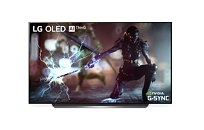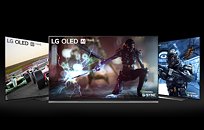Friday, November 1st 2019

LG OLED TVs Receive NVIDIA G-SYNC Upgrade Starting This Week
LG Electronics USA announced that 2019 OLED TVs are receiving a firmware update starting this week, enabling stunning game play via NVIDIA G-SYNC Compatible technology.
NVIDIA G-SYNC Compatible support will be available on the E9 series (65 and 55 inches) and C9 series (77, 65 and 55 inches) as well as the B9 series (65 and 55 inches) LG OLED TV models in the United States in November.With G-SYNC Compatible support, the critically-acclaimed LG OLED TVs will deliver the smoothest, most immersive gaming experience without the flicker, tearing or stuttering common to most displays. Gamers have long valued LG OLED TVs for their exceptional picture quality, low input lag and ultra-fast response time. The addition of G-SYNC Compatible support allows gamers with GeForce RTX 20-Series or GTX 16-Series GPUs to fully enjoy extreme responsiveness and optimized visuals on LG's large OLED TVs from 55 inches up to an immersive 77 inches.
"If you'll pardon the pun, this is truly a game changer for the legions of gamers out there," said Tim Alessi, head of home entertainment product marketing at LG Electronics USA. "Partnering with NVIDIA to integrate their G-SYNC Compatible support into our category-leading LG OLED TVs delivers a new standard in gaming performance and opens a new world of large-screen 4K gaming experiences only found on LG OLED TVs."
For more information on LG TVs, visit LG.com.
NVIDIA G-SYNC Compatible support will be available on the E9 series (65 and 55 inches) and C9 series (77, 65 and 55 inches) as well as the B9 series (65 and 55 inches) LG OLED TV models in the United States in November.With G-SYNC Compatible support, the critically-acclaimed LG OLED TVs will deliver the smoothest, most immersive gaming experience without the flicker, tearing or stuttering common to most displays. Gamers have long valued LG OLED TVs for their exceptional picture quality, low input lag and ultra-fast response time. The addition of G-SYNC Compatible support allows gamers with GeForce RTX 20-Series or GTX 16-Series GPUs to fully enjoy extreme responsiveness and optimized visuals on LG's large OLED TVs from 55 inches up to an immersive 77 inches.
"If you'll pardon the pun, this is truly a game changer for the legions of gamers out there," said Tim Alessi, head of home entertainment product marketing at LG Electronics USA. "Partnering with NVIDIA to integrate their G-SYNC Compatible support into our category-leading LG OLED TVs delivers a new standard in gaming performance and opens a new world of large-screen 4K gaming experiences only found on LG OLED TVs."
For more information on LG TVs, visit LG.com.


60 Comments on LG OLED TVs Receive NVIDIA G-SYNC Upgrade Starting This Week
So restricting this to just LG's TVs right now also makes sense. Because no other TV maker has the feature implemented. Samsung has FreeSync support, but it is not the same as the standard VRR. As more TV makers actually get this implemented, I'm sure the support will be extended to them.
This is not Nvidia stealing FreeSync HDMI. This is Nvidia beating AMD to the punch in supporting the standard. Everyone trying to cast this as just marketing doesn't really understand the technical hurdles of actually making this happen. I don't think Nvidia will ever support FreeSync HDMI. Future monitors will include HDMI 2.1 VRR and Nvidia will be in a place to enable it more broadly once all of the disparate engineering teams finally implement it in a universal, standards-compliant way. I hope AMD catches up soon.
So nothing forces TV manufacturers to use 4k high refresh rate panels, but they all do anyway. LG, Sony, Samsung, Vizio (P series at least). You can check rtings.com for the model to see if it supports 1080p120 and that will tell you what the panel supports for refresh rate. The missing part is the rest of the chain, and my guess is it's really down to the availability of commodity 2.1 support in the HDMI interface board.
Freesync version of same display usually have same performance just like their G-Sync counterparts. It's just g-sync module came with adaptive overdrive and usually Freesync module don't support that.
And by the way G-sync module is a FPGA so even nvidia themself didn't plan to sell that thing for such long time.
And on big thing about this news is this is first time nvidia supporting VRR via HDMI. No graphics card from nvidia support HDMI 2.1 yet, this is Freesync via HDMI 2.0. Currently only Geforce Beta driver for Windows Insiders have this ability.
and uninformed at the same time too.freesync was never any worse than gsync when they both worked as intended.g-sync monitors have ulmb+adaptive v-sync in drivers,and that's pretty much where the advantages end.most pople are not willing to pay the premium for that,though in my experience it's pretty mind boggling,not even in shooters but particularly in parkour or melee first person games like dying light or shadow warrior.If one can afford it I'd definitely recommend for them to try.
there's low framerate compensation too,but trying to make sub-30 fps gaming better is like turbocharging a Zastava so not really of any importance.Who in their sane mind spends $500-1000 on a monitor and cares about LFC.really.
ghosting issues ? they were probably caused by the fact that you could certify any piece of crap as freesync,while for g-sync you could not.
anyway,I reported your poor attempts to get me banned for an alt account to the staff,and we have a pretty decent idea who you are too.strangely your main account activity is somehow related to the posts with the alt one.I guess the only argument you could win on TPU is with yourself :roll: :laugh:
2. Stuttering? FreeSync is not plagued by stuttering.
You make a few unfounded claims because there isn't a single tech outlet that backs up your claims.
FPGA makes more $ense than ASIC for low volumes. Nvidia understands the ecnomics involved.
The title is kind of misleading, should be "LG OLED TV's recieve 'G-SYNC Compatible Certification'."
www.nvidia.com/en-us/geforce/products/g-sync-monitors/specs/
This feature is currently the only feature that is missing on almost every Freesync display and that's it. G-SYNC didn't give them any more than this.
G-SYNC module is a total joke considers nvidia is a ASIC design company.
No, in actuality no consumer outside of here gives a shit about that. They just want to know what GPU this solution is promised to work with.
This is promised to work with nvidia, so they used nvidia branding. The fact that most vendors choose nvidia brand indicators over AMD ones is not false advertising either, they probably test it on the market leader (which, like it or not, is nvidia). They may work with AMD too, but few even consider that fact worth marketing anymore. That's a problem with AMDs brand position and generally having been poor competition for 2+ years, not a nvidia scam routine.
Playing the AMD-victim card regularly is going to become part of their brand too, if I keep reading crap like this.
It's irrelevant who's brand is in a better position, when a company uses their brands they do it on the basis of a partnership that entails certain restrictions. And thus we get to the real reason why this is a problem, Nvidia is clearly doing something which makes manufactures want to avoid mentioning AMD.
You know, a year ago Nvidia was also a market leader and AMD in an arguably worse position and yet manufactures where happily slapping AMD/Freesync on everything, surely there is more to it than just brand recognition.
If you want to blame anyone, blame the vendors, and capitalism maybe.
AMD has limited market share yet their brand manages to make it's way to a lot of manufactures. (This is pre G-sync compatible)
Nvidia enables compatibility on non G-sync displays, AMD's brand starts to get removed from existing and new products.
Potential customers with AMD hardware didn't vanish and might have even grown in numbers so why would a vendor stop advertising something which they previously did with no problem ? This cannot be explained with market share, in fact it makes absolutely no sense, both AMD and Nvidia can help extend their reach. There is no reason to exclude one or the other.
A vendor would always want to list as many compatible products as possible, not just pick one because it has the highest market share. This is of course if nothing constricts them.
That was my point.
Even then, if one has to choose between advertising freesync or gsync, the market choice is obvious. Of course until I see evidence of such an agreement existing I won't even begin to comment on the theoretical anticompetitive nature of it.
- HMDI 2.1 is nonexistent on PC
- PC gamers mostly use desktop displays, not many of them have 55" OLED plugged to their PC
- console market atm is dominated by AMD as hardware supplier,
So if future OLEDs from LG will include VRR support (which AFAIK is required for full HMDI 2.1 support) the ones that will benefit the most from it are owners of nextgen consoles that will be based on AMD hardware.
if you waste your money on a gaming 27" or smaller shame on you.
funny most people say "oh the 55" doesn't fit my allotted space" well then first thing you need to do is focus on getting a bigger room! then a bigger TV then have a better experience ;P went from 21" trinitron to a LG 37" to a 43"4k to a 55"1440@120hz samsung tv / 65"depending on the room. even my mom uses a 4k 43+" tv for her desktop. welcome to 5+ years ago :)
The thing is that it's HDMI 2.1 VRR and there are no GPUs for it. Xbox One was be the only source capable of this particular VRR solution until now.
I don't understand the hate, it's a free update adding features, the better VRR works on all cards, the better for us.